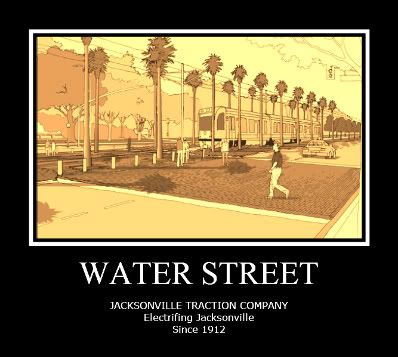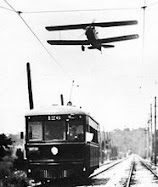

Published: May 20, 2007
JACKSONVILLE'S TRANSPORTATION PUNDIT GIVES YOU NEWS, OPINION AND INFORMATION, REIGONAL AND THE WORLD.


 Photo: Station - Gare De Lyon, France, on the outside not unlike Jacksonville Terminal
Photo: Station - Gare De Lyon, France, on the outside not unlike Jacksonville Terminal WHAT WOULD A STREETCAR AND SKYWAY DO FOR JTA BUSES?
WHAT WOULD A STREETCAR AND SKYWAY DO FOR JTA BUSES?




 Photos of the Shweeb System test track, Imagine Berkman, Baptist, Hyatt, Landing, Cummer, Atena, Prudential, MOSH, Maritime Museum, Shipyards, Strand, Peninsular, Ruths Chris, Brewing Company, Marina, Friendship Fountain... IMAGINE - JACKSONVILLE - IMAGINE!
Photos of the Shweeb System test track, Imagine Berkman, Baptist, Hyatt, Landing, Cummer, Atena, Prudential, MOSH, Maritime Museum, Shipyards, Strand, Peninsular, Ruths Chris, Brewing Company, Marina, Friendship Fountain... IMAGINE - JACKSONVILLE - IMAGINE!  Photo: Tram in Milan, Italy, next stop... "Sweet Home Alabama..."
Photo: Tram in Milan, Italy, next stop... "Sweet Home Alabama..."


For 30 years, I have played the attack dog for lame transit schemes that have rolled out of city hall in Jacksonville. The latest of these attacks have been directed at JTA's BRT system. Perhaps it's time to explain my stand on BUS RAPID TRANSIT and how it would and wouldn't work in Jacksonville.
First understand, no one can quite explain what Bus Rapid Transit, or BRT, really is. To make it elementary, let's just say it is a cafe or smorgasbord of bus transit toys, laid out to pick and choose from. Depending on the extent of investment and the number of additions and betterment's, a regular bus provider can become a magic BRT magnet.
BRT comes in two forms, the very expensive, first proposed for Jacksonville, rivals Light Rail in Costs, with few extra benefits and at least an equal number of faults. This system is known as "QUICKWAY". Usually it involves completely grade separated bus ways, without a single cross street, pedestrian cross walk, or railroad crossing. In effect a freeway for buses. Stations are grand affairs, some with shopping and other services built in. Buses run fast and frequent. Other features might include railroad like signals for traffic control, real time digital information signs, ground level boarding, GPS bus locating service. In short, it's a great concept for a medium to high density route with very frequent "headways" (times between buses). A decent example of the QUICKWAY system is the Miami-Dade Kendall Busway, where a perfectly good railroad was torn out, graded flat and paved over.
The second form of BRT is what JTA claims, it is now pursuing. Known as LIGHT-RAIL-LITE-BRT, It would include only some of the above. In fact the buses might operate in an HOV or commuter lane in the local freeway or arterial road. There might be a few pull-offs, some digital signs, traffic light priority, even que jumping bus lanes, for the ever long lines at the traffic signals. In short it is a discount way to still build a system of BRT without the hundreds of Millions involved in building bus only freeways or "Quickways." Los Angeles, is chock full of examples of the LIGHT-RAIL-LITE-BRT model.
Your JACKSONVILLE TRANSIT BLOGGER is neither for nor against either type of system. As they would apply to a City with few other options, South Florida for example, BRT often makes the most sense. However, whenever highway lobbyist push for replacement of existing railways for a two or three lane quickway, my hair stands on end.
Why scrap a perfectly good railroad for a new concept, that even in it's most expensive form is still being sold as "Like rail only cheaper."
Facts are facts and frankly, while select rail projects, Light Rail and Modern or Heritage Streetcars can be found that cost $30 - $50 Million a mile, this in and of itself shouldn't qualify BRT as superior.
BRT doesn't have a track record in this country of attracting developers, the reasons stated by Mr. Mike Miller of JTA, in the BRT meetings. "If a route turns out that it doesn't work, we can just move it..." THAT is EXACTLY why nobody is going to plunk down $200 Million dollars on a new downtown high rise, because it's close to a BRT line. Here today, gone tomorrow.
A few other reasons why BRT in Quickway form is useless in most of Jacksonville. It will cost more then a simple Light Rail System. Starting with Heritage vehicles, streetcar lines have been recently built for as low as $3 Million dollars a mile, with many deluxe projects coming in at $10 or $15 Million a mile. Streetcars are not oil dependent, electric current, a simple 600 volt DC system can be provided by tidal action in the river, by wave action at the beach, by wind generators at the jetties, by any form of fuel, including solar power. The entire system in Edmonton, Canada, is wind powered in a branded marketing campaign called "RIDE THE WIND..."
So rail doesn't pollute, or at least doesn't need to. Rail can be placed in the street, curb, sidewalk, on private land, down an old unused freight branchline, up a Greenway, in a median, on a bridge or some combination of all of the above.
But it's not the end of the world for BRT advocates in Jacksonville. We citizens deserve the best of the best in Transit, and the World is our shopping mart. BRT in a semi-Quickway to the beaches could even be designed for someday conversion to Light Rail. The new Matthews Bridge could share BRT and SKYWAY or LRT as it brings mass transit into Arlington.
A properly laid out core of rail trunk lines could replace the current BRT plans for Southwest Jacksonville, (commuter trains), Southbank and Southeast Jacksonville, (commuter trains - Skyway - Streetcars) , North Jacksonville is a natural for an easy combo of Commuter Rail (The old "S" line-Greenway, Rapid Streetcars Gateway Mall - Downtown) . Note that we didn't wipe out the BRT plans for Arlington, nor did we take them out of the other areas. We just move them to the ends of the rail lines. For example, step off the train at Airport Station and a BRT bus meets you across the platform to whisk you to the Airport or River City Marketplace. Step off in Yukon, and the NAS bus takes you to work on the base. At Union Station other Light-Rail-Lite-BRT systems take you west to US 90 or I-10, Normandy.
I don't see the future of JTA as a ONE SIZE FITS ALL transit system. It won't work and never has. By layering non-competitive-complimentary layers over the city, we offer Choice, Speed, Comfort and Safety.
Now don't get me started on Comfort, do a blog search for the "SILVER EAGLE MODEL 15 Coach" Add bathroom and Starbucks bar and we'd have to beat the passengers off the longer run s. Let's work together to built our broken stepchild JTA system into a World Leader. Mr. Mayor? Mr. Blaylock? Pick up the phone.
 WHAT IS IT ABOUT HERITAGE STREETCARS THAT MAKE DEVELOPERS AND POLITICIANS WANT TO DANCE?
WHAT IS IT ABOUT HERITAGE STREETCARS THAT MAKE DEVELOPERS AND POLITICIANS WANT TO DANCE?
Augusta Trolley Study is Mostly Praised
By Sylvia Cooper, staff writer
The Augusta Chronicle
The Downtown Development Authority's plan to spend $37,000 in special-purpose sales-tax money for a trolley study received mostly positive reviews from Augusta commissioners Monday.
"I think if we do something like this it will put us on the cutting edge," said Mayor Pro Tem Betty Beard. "This would be a tremendous beginning."
Commissioner Calvin Holland said it is what he calls "thinking outside the box."
But Commissioner Jerry Brigham had questions about long-term costs.
"We know the city of Atlanta has the MARTA tax to underwrite public transit," he said. "Augusta doesn't have a MARTA tax. How are we going to fund the long-term costs of operations? That's the real question."
The Augusta transit system already loses about $4 million a year, and that loss is covered by transfers from the general fund that come mainly from property taxes.
The authority's executive director, Margaret Woodard, said a trolley could help revitalize downtown Augusta by promoting economic development on its route.
"Twenty to 30 times what you invest in a trolley is going to come back in re-development," she said. "Little Rock's return on investment was 920 percent. Developers want to develop along the line for two reasons. No. 1, it shows a real commitment by the city to invest in some type of transportation that's energy-efficient, and No. 2, they don't have to build parking as much as they would."
The 4.5-mile light rail track would run on Broad Street, along part of the Augusta Canal and up 15Th Street to the Medical College of Georgia complex, with the expectation that people would ride it downtown for lunch.
Commissioner Don Grantham proposed a 60- to 90-day trial of that concept using a bus, but transit planner Uriah Lewis said that had been tried before and didn't work due to traffic in the area around Harper Street.
Fifty percent of the money to build the track, estimated to cost between $50 million and $175 million, could be paid for with money from the federal Small Starts programs and the private sector, Ms. Woodard said.
In addition, it could possibly be powered by the Augusta Canal, making it the first such trolley system in the country, she said.
BLOGGER COMMENTS:
Shame on Jacksonville, for backwoods thinking, small town planning, and good old boy transit deals. We created the TPC and took the home of the PGA TOUR and yet Augusta still wows the international golf community with the "Masters" and those stupid green jackets.
For 30 years, since the days of Jake Godbold, I have been pounding the bricks with these development numbers, often in a friendless one man war to shake some sense into our city.
When I started this, San Diego was the first City in 40 years to construct (then under construction on an old rail line) a new Streetcar or LRT line. Portland, Oregon was "Talking about it but nothing looked promising..." I presented Jacksonville Downtown Development Authority with a plan to use some of our old and original streetcars, REBUILT. Oddly enough about 4.5 miles to the inch in length. To revive the dead, to bring back something of a specter, to the streets of Jacksonville. Unique to our city. Once the greatest Traction system in Florida, I reasoned it would be as big an East Coast attraction as San Francisco's cable cars are out west. Well, sadly I was wrong. Jacksonville quietly asked me to shut up and go away, and we never built the first HERITAGE TROLLEY SYSTEM. We ignored it even as one or two other towns and Cities tried it. We cut up 5 perfectly good Jacksonville Trolleys during the next 30 years. Today, 68+ Cities have this concept. The amazing thing is even the newest ones are still bringing in returns of 30 - *920% on every dollar invested. You'd think some Jacksonville developers, hotels or the Landing would call me, you'd think the politicians would want me as their best friend, you'd think I'd be leading a think tank over at JTA... You'd be wrong. This is Jacksonville, a place where our own streetcars once wore a jacket of Augusta green.
Amazing.
*(Little Rock, Arkansas has a similar length line, and has hit a 920% return on investment)

Sign by Danasoft - For Backgrounds and Layouts
Jacksonville |


